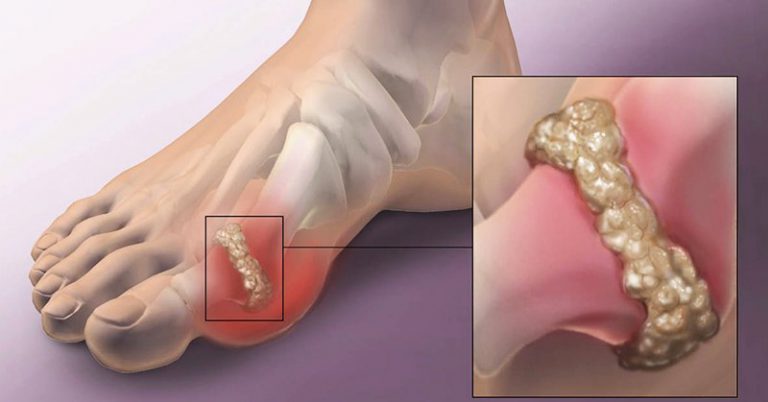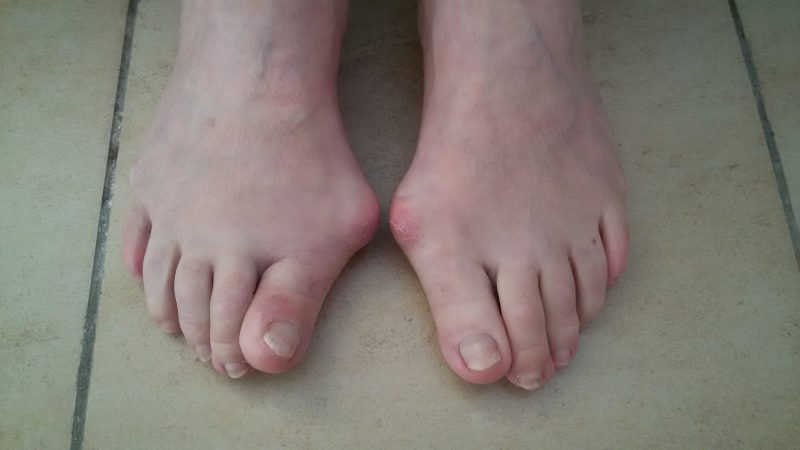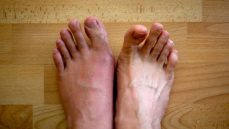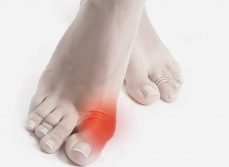Many people suffer from joint diseases now. Gout on the legs is one of the most common ailments of all time, which is characterized by the deposition of excess salts of uric acid in the joints.
Material Content:
Causes of gout on the legs
Normally, an insignificant concentration of uric acid in the body does not harm a person, since it is excreted by the excretory system. But with its excess, salts begin to be deposited in the joints. This condition is so painful that during periods of exacerbation, a person can completely lose working capacity and even become disabled.
The main cause of this metabolic disease is an elevated level of uric acid in the blood or hyperuricemia.
A similar problem often arises due to the fact that the kidneys simply cannot timely "pass" out an excessive amount of uric acid. In another case, the diseased organs do not perform their functions and cannot even cope with a small volume of this substance.
Interestingly, gout used to be called the “disease of the kings”, since it was diagnosed only by noble and wealthy people who moved little, ate a lot and had a predilection for wine and beer. Nowadays, people who abuse fatty meats, fish and like to drink are also especially affected by this disease. Such foods and "strong" drinks are saturated with purines, the processing of which produces an excessive amount of toxin.
Therefore, the main reasons for the development of pathology are as follows:
- kidney disease
- sedentary lifestyle;
- obesity;
- constant overeating;
- fatty meat abuse.
Very rarely, the disease occurs due to hereditary failures, but these are isolated cases.
Signs and symptoms of the disease
Gout is considered mainly a male disease (10-50 cases per 1 thousand people). The most dangerous age is 40-50 years. Women are faced with a similar problem quite rarely, only during menopause and later (approximately 1-7 cases per 1,000 people). The first phase of the disease is asymptomatic, and only in the results of the tests can you see the excess of uric acid.
Signs of gout on the legs of women and men with a classic attack are as follows:
- inflammatory process (mainly the joint of the big toe);
- unbearable pain;
- redness of the skin;
- heat;
- general deterioration of well-being.
This condition is known as an attack of gouty arthritis. For the first time, it arises as a result of a sharp provocative factor - hypothermia, trauma, intake of a large amount of alcoholic beverages or fatty foods.
As a rule, exacerbation occurs in the morning or at night. In the afternoon, the pain becomes less pronounced. By night, the symptoms intensify again, and the pain becomes unbearable. The duration of the attack varies from 2 days to a week.
Frequently recurring painful periods lead to inflammation, impaired functioning and destruction of neighboring joints. After the first attack, the next can be repeated after 7-12 months, then the disease again goes into a latent phase. But over time, the intervals between exacerbated conditions become less and less long.
5-6 years after the manifestation of the pathology, peculiar growths often appear on the patient's fingers - tofuses that can burst. In the depths of these painful wounds, white crystals of uric acid can be seen.
Diagnostic measures
An experienced doctor can accurately diagnose it at the first examination. However, in most cases, the patient is prescribed additional studies - a biochemical blood test, radiography or puncture of the joints, a biopsy of tofus, ultrasound of the kidneys. All these data are needed to determine the severity and stage of the disease.
Treatment of gout in men and women
Unfortunately, gout on the legs of men and women is a chronic disease, so it’s impossible to get rid of it even with the latest drugs. But correctly selected therapy and scrupulous adherence to a diet can increase the intervals between exacerbations and help a person lead a normal lifestyle.
 Effective drugs
Effective drugs
The principle of gout treatment is the constant monitoring of uric acid levels. When first contacting a doctor and making a diagnosis, as a rule, anti-inflammatory tablets and drugs that lower the concentration of toxin are prescribed (Ulorik, Santuril).
In order to stop the symptoms of exacerbation (pain and swelling), it is recommended to drink Colchicine, which prevents the urates from being converted into crystals. The medicine often causes unpleasant side reactions - nausea, stool disorders, but helps to quickly localize the attack.
Of the effective ointments for gout can be called Diclofenac, Fullflex, Indomethacin. Of course, such drugs have only a local spectrum of exposure and are intended not to treat the disease, but to relieve pain and inflammation.
Without adequate therapy, the disease destroys tissues very quickly, especially in the elderly. Therefore, early treatment is the key to achieving long-term remission.
Folk remedies
To alleviate an acute attack at home is very difficult. In the best case, the measures taken will help reduce its duration. The first and most important condition is mandatory bed rest, while the diseased limb must lie on a raised platform. During a relapse, a compress of ice can be applied to a large place.
Popular folk recipes:
- Chamomile decoction. For 100 g of dry inflorescences, pour 10 ml of boiling water, adding 20 g of salt. Stir and insist closed. Make foot baths.
- Onion. Take 2-3 large onions in the husk, pour 5 tbsp. water, cook until tender. Drink a glass three times a day for a half to two weeks.
- Infusion of unopened fir cones. One of them pour 300 ml of boiling water and leave until morning. Use during the day half an hour before meals in three divided doses.
- Bay leaf. Five grams of raw material pour 300 ml of water and bring to a boil. Heat for about five minutes. Wrap the broth in a warm blanket and insist up to 3 hours. Drink in small portions for 12 hours.
If there are no problems with the kidneys, then at least 2.5 liters of liquid must be consumed per day: water with lemon juice, oat jelly, milk.
Gout Diet
From the patient's diet, it is necessary to exclude meat and fish dishes, mushrooms, beans, peas, salt to the maximum. Cooking should be based on the use of whole grains, eggs (in small quantities), as well as dairy products, vegetables and fruits. Among the last ingredients, sorrel, spinach, and cauliflower are forbidden.
Of the drinks, green tea, decoctions of herbs, purified water with lemon slices, and fresh cucumber juice should be preferred. Dishes are best served in liquid or semi-liquid form.
Patients need to monitor their weight, as the need for calories is completely met by carbohydrates, which can lead to a quick set of extra pounds.
It is very useful for gout patients to arrange fasting days from time to time - to eat only one type of vegetable or fruit. As an option - it can be unloading in milk, rice, kefir or cottage cheese. Fasting is not necessary so as not to sharply increase the level of uric acid. Therefore, you should eat before saturation and do not skip meals.
Complications of the disease
The most common complications are gouty arthritis, urolithiasis, and kidney failure. The latter pathology can be fatal.
However, timely diagnosis and the rapid start of treatment give a relatively favorable prognosis, since, following the recommendations of the doctor, a person can lead a full life.
Optimistic assumptions are significantly exacerbated by objective factors:
- burdened history (the presence of diabetes mellitus, high blood pressure);
- young age (up to 35 years);
- progression of kidney disease.
Relatives of the patient should also independently monitor the concentration of uric acid, as they automatically fall into the risk group.
Prevention
Very often, pathology appears where the joint was once injured. Therefore, it is necessary to wear comfortable and uncomfortable shoes that do not pinch the feet and do not interfere with the normal movement of blood.
The main preventive measure is proper nutrition and weight control. Refusing bad habits is also a huge step towards the health of joints and the whole body.
It is very useful to often do simple gymnastic exercises for the fingers of the lower extremities. The disease most often affects small joints, which in ordinary life move little, so it is advisable to devote enough time to such activities.
In order to reduce the risk of exacerbations, the patient must adhere to the following simple rules:
- Try to minimize the likelihood of injury to the affected joints.
- Monitor uric acid concentration. The maximum allowable figure is 60 mg / g.
- Every day you need to devote at least 40-80 minutes to simple physical exercises - swimming, walking, cycling or even just walking. Morning exercise is mandatory, because moderate physical activity can replace a whole set of expensive medications.
- Drink from 2 liters of water per day. This is vital.Only under this condition the excretory system is able to cope with its functions. Without a sufficient volume of fluid, even healthy organs will not be able to cleanse the body of excess unnecessary substances.
- Follow the rules recommended by your doctor diet. If possible, supplement the menu with a good mineral and vitamin complex.
Research results have confirmed that there is a direct correlation between the development of pathology and a lack of calcium and vitamin C. Therefore, sometimes the disease develops even in those people who lead a healthy lifestyle, eat right, do not gain extra pounds. With age, they experience a lack of these substances, so it is advisable to take multivitamins, after consulting with your doctor.
















